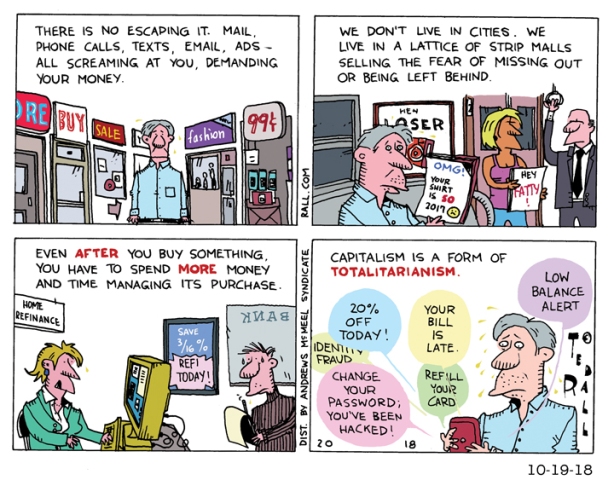Special mention
Archive for October, 2018
Cartoon of the day
Posted: 29 October 2018 in UncategorizedTags: Brazil, cartoon, fascism, terrorism, Trump, United States, violence
Cartoon of the day
Posted: 28 October 2018 in UncategorizedTags: cartoon, Central America, immigrants, immigration, lottery, terrorism, Trump, United States
Cartoon of the day
Posted: 27 October 2018 in UncategorizedTags: Brazil, cartoon, conservative, fascism, liberal, military, tax cuts, taxes, trickledown, Trump
Cartoon of the day
Posted: 25 October 2018 in UncategorizedTags: cartoon, democracy, fascism, middle-class, tax cuts, Trump
Cartoon of the day
Posted: 24 October 2018 in UncategorizedTags: capitalism, cartoon, consumption, GOP, Republicans, Saudi Arabia, tax cuts, Trump
Sciences of inequality
Posted: 23 October 2018 in UncategorizedTags: class, corporations, economics, environment, exploitation, inequality, Joseph Stiglitz, markets, neoclassical, New Deal, poverty, power, regulations, rent, science, trust, United States, Wall Street

Last month, Philip Alston, the United Nations Special Rapporteur on extreme poverty and human rights (whose important work I have written about before), issued a tweet about the new poverty and healthcare numbers in the United States along with a challenge to the administration of Donald Trump (which in June decided to voluntarily remove itself from membership in the United Nations Human Rights Council after Alston issued a report on his 2017 mission to the United States).
The numbers for 2017 are indeed stupefying: more than 45 million Americans (13.9 percent of the population) were poor (according to the Supplemental Poverty Measure*), while 28.5 million (or 8.8 percent) did not have health insurance at any point during the year.
But the situation in the United States is even worse than widespread poverty and lack of access to decent healthcare. It’s high economic inequality, which according to a new report in Scientific American “negatively impacts nearly every aspect of human well-being—as well as the health of the biosphere.”
As Robert Sapolsky (unfortunately behind a paywall) explains, every step down the socioeconomic ladder, starting at the very top, is associated with worse health. Part of the problem, not surprisingly, stems from health risks (such as smoking and alcohol consumption) and protective factors (like health insurance and health-club memberships). But that’s only part of the explanation. But that’s only part of the explanation. The rest has to do with the “stressful psychosocial consequences” of low socioeconomic status.
while poverty is bad for your health, poverty amid plenty—inequality—can be worse by just about any measure: infant mortality, overall life expectancy, obesity, murder rates, and more. Health is particularly corroded by your nose constantly being rubbed in what you do not have.
It’s not only bodies that suffer from inequality. The natural environment, too, is negatively affected by the large and growing gap between the tiny group at the top and everyone else. According to James Boyce (also behind a paywall), more inequality leads to more environmental degradation—because the people who benefit from using or abusing the environment are economically and politically more powerful than those who are harmed. Moreover, those at the bottom—with less economic and political power—end up “bearing a disproportionate share of the environmental injury.”
Social and institutional trust, too, decline with growing inequality. And, as Bo Rothstein explains, societies like that of the United States can get trapped in a “feedback loop of corruption, distrust and inequality.”
Voters may realize they would benefit from policies that reduce inequality, but their distrust of one another and of their institutions prevents the political system from acting in the way they would prefer.
But what are the economics behind the kind of degrading and destructive inequality we’ve been witnessing in the United States in recent decades? For that, Scientific American turned to Nobel laureate Joseph Stiglitz for an explanation. Readers of this blog will be on familiar ground. As I’ve explained before (e.g., here), Stiglitz criticizes the “fictional narrative” of neoclassical economics, according to which everyone gets what they deserve through markets (which “may at one time have assuaged the guilt of those at the top and persuaded everyone else to accept this sorry state of affairs”), and offers an alternative explanation based on the shift from manufacturing to services (which in his view is a “winner-takes-all system”) and a political rewriting of the rules of economic game (in favor of large corporations, financial institutions, and pharmaceutical companies and against labor). So, for Stiglitz, the science of inequality is based on a set of power-related “market imperfections” that permit those at the top to engage in extracting rents (that is, in withdrawing “income from the national pie that is incommensurate with societal contribution”).
The major problem with Stiglitz’s “science” of economic inequality is that he fails to account for how the United States underwent a transition from less inequality (in the initial postwar period) to growing inequality (since the early 1980s). In order to accomplish that feat, he would need to look elsewhere, to the alternative science of exploitation.
While Stiglitz does mention exploitation at the beginning of his own account (with respect to American slavery), he then drops it from his approach in favor of rent extraction and market imperfections. If he’d followed his initial thrust, he might have been able to explain how—while New Deal reforms and World War II managed to engineer the shift from agriculture to manufacturing, reined in large corporations and Wall Street, and bolstered labor unions—what was kept intact was the ability of capital to appropriate and distribute the surplus produced by workers. Thus, American employers, however regulated, retained both the interest and the means to avoid and attempt to undo those regulations. And eventually they succeeded.
What is missing, then, from Stiglitz’s account is a third possibility, an approach that combines a focus on markets with power, that is, a class analysis of the distribution of income. According to this science of exploitation or class, markets are absolutely central to capitalism—on both the input side (e.g., when workers sell their labor power to capitalists) and the output side (when capitalists sell the finished goods to realize their value and capture profits). But so is power: workers are forced to have the freedom to sell their labor to capitalists because it has no use-value for them; and capitalists, who have access to the money to purchase the labor power, do so because they can productively consume it in order to appropriate the surplus-value the workers create.
That’s the first stage of the analysis, when markets and power combine to generate the surplus-value capitalists are able to realize in the form of profits. And that’s under the assumption that markets are competitive, that is, there are not market imperfections such as monopoly power. It is literally a different reading of commodity values and profits, and therefore a critique of the idea that capitalist factors of production “get what they deserve.” They don’t, because of the existence of class exploitation.
But what if markets aren’t competitive? What if, for example, there is some kind of monopoly power? Well, it depends on what industry or sector we’re referring to. Let’s take one of the industries mentioned by Stiglitz: Big Pharma. In the case where giant pharmaceutical companies are able to sell the commodities they produce at a price greater than their value, they are able to appropriate surplus from their own workers and to receive a distribution of surplus from other companies, when they pay for the drugs covered in their health-care plans. As a result, the rate of profit for the pharmaceutical companies rises (as their monopoly power increases) and the rate of profit for other employers falls (unless, of course, they can change their healthcare plans or cut some other distribution of their surplus-value).**
The analysis could go on. My only point is to point out there’s a third possibility in the debate over growing inequality in the United States—a theory that is missing from Stiglitz’s article and from Scientific American’s entire report on inequality, a science that combines markets and power and is focused on the role of class in making sense of the obscene levels of inequality that are destroying nearly every aspect of human well-being including the natural environment in the United States today.
And, of course, that third approach has policy implications very different from the others—not to force workers to increase their productivity in order to receive higher wages through the labor market or to hope that decreasing market concentration will make the distribution of income more equal, but instead to attack the problem at its source. That would mean changing both markets and power with the goal of eliminating class exploitation.
*The official rate was 12.3 percent, which means that 39.7 million Americans fell below the poverty line.
**This is one of the reasons capitalist employers might support “affordable” healthcare, to raise their rates of profit.























